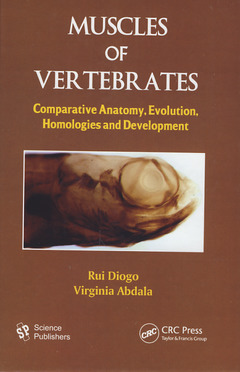Muscles of Vertebrates Comparative Anatomy, Evolution, Homologies and Development
Auteurs : Diogo Rui, Abdala Virginia

The Vertebrata is one of the most speciose groups of animals, comprising more than 58,000 living species. This book provides a detailed account on the comparative anatomy, development, homologies and evolution of the head, neck, pectoral and forelimb muscles of vertebrates. It includes hundreds of illustrations, as well as numerous tables showing the homologies between the muscles of all the major extant vertebrate taxa, including lampreys, elasmobranchs, hagfish, coelacanths, dipnoans, actinistians, teleosts, halecomorphs, ginglymodians, chondrosteans, caecilians, anurans, urodeles, turtles, lepidosaurs, crocodylians, birds, and mammals such as monotremes, rodents, tree-shrews, flying lemurs and primates, including modern humans. It also provides a list of more than a thousand synonyms that have been used by other authors to designate these muscles in the literature. Importantly, it also reviews data obtained in the fields of evolutionary developmental biology, molecular biology and embryology, and explains how this data helps to understand the evolution and homologies of vertebrate muscles.
The book will useful to students, teachers, and researchers working in fields such as functional morphology, ecomorphology, evolutionary developmental biology, zoology, molecular biology, evolution, and phylogeny. As the book includes crucial information about the anatomy, development, homologies, evolution and muscular abnormalities of our own species, Homo sapiens, it will also be helpful to physicians and medical students.
Introduction and Aims. Methodology and Material. Muscles of Non-Osteichthyan Vertebrates. Head and Neck Muscles of Actinopterygians and Basal Sarcopterygians. From Sarcopterygian Fish to Modern Humans: Head and Neck Muscles. Head and Neck Muscles of Amphibians. Head and Neck Muscles of Reptiles. Pectoral and Pectoral Fin Muscles of Actinopterygian and Sarcopterygian Fishes. From Sarcopterygian Fish to Modern Humans: Pectoral and Forelimb Muscles. Pectoral and Forelimb Muscles of Limbed Amphibians and Reptiles. General Comments.
Rui Diogo: Dept of Anthropology, George Washington University, USA
Virginia Abdala: Professor, Universidad Nacional de Tucumán, Argentina
Date de parution : 07-2010
Ouvrage de 482 p.
15.6x23.4 cm
Thème de Muscles of Vertebrates :
Mots-clés :
Adductor Mandibulae; Depressor Mandibulae; Muscles of Non-Osteichthyan Vertebrates; Hypobranchial Muscles; Head and Neck Muscles of Actinopterygians and Basal Sarcopterygians; Adductor Operculi; Head and Neck Muscles of Reptiles; Levator Hyoideus; From Sarcopterygian Fish to Modern Humans: Pectoral and Forelimb Muscles; Branchial Muscles; Pectoral and Forelimb Muscles of Limbed Amphibians and Reptiles; Cephalic Musculature; Levator Operculi; Adductor Hyomandibulae; Dilatator Operculi; Branchial Muscles Sensu Stricto; Protractor Hyoideus; Pectoral Fi; La Ri; Protractor Pectoralis; Rectus Cervicus; Arrector Ventralis; Constrictor Dorsalis; Lungfi Shes; Pe Rc; Constrictor Hyoideus; Adductor Mandibulae A2 PVM; Zebrafi Sh; Pectoral Ray; Pectoral Girdle Musculature



